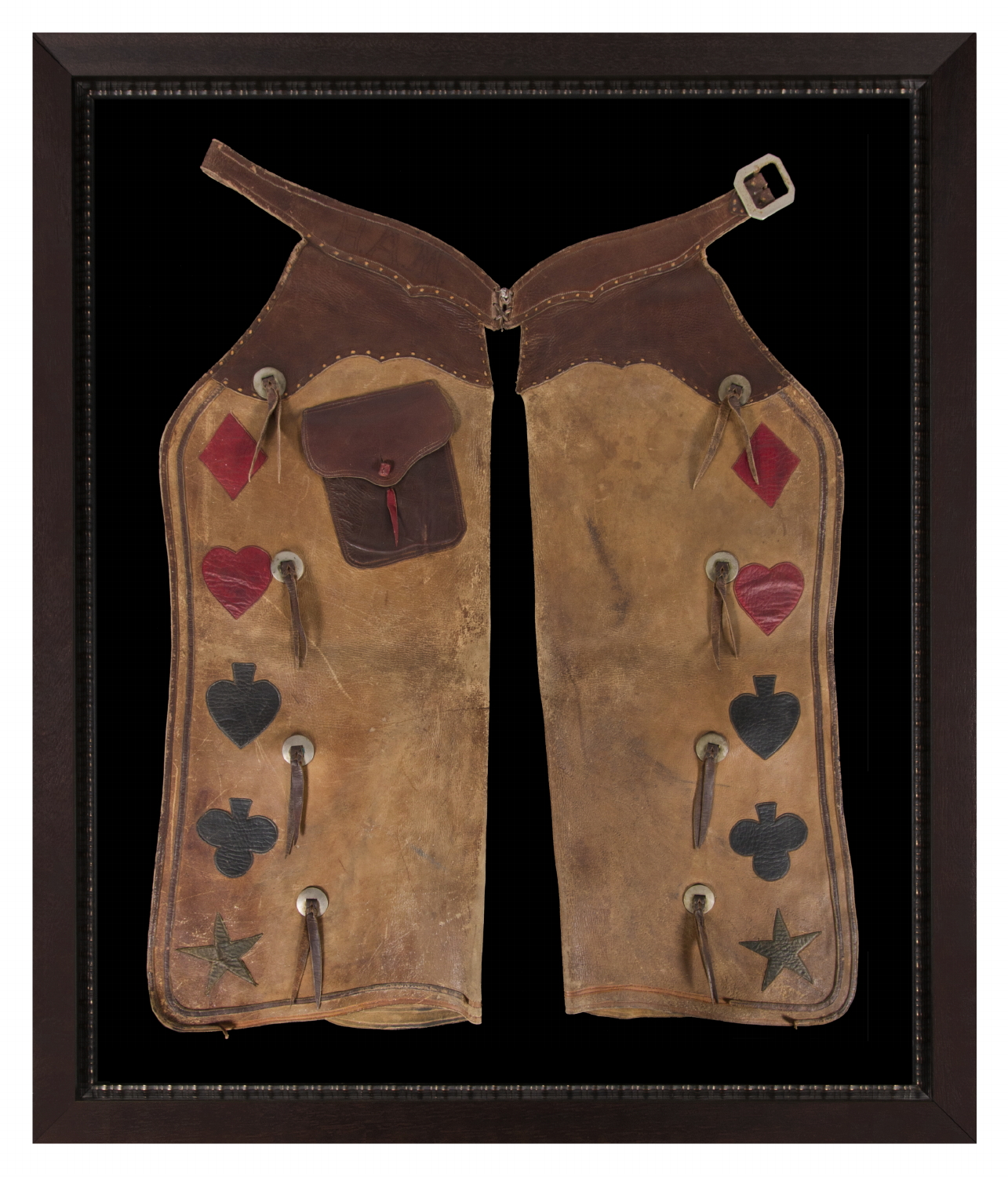
| |
BATWING, LEATHER CHAPS WITH PLAYING CARD SYMBOLS & STARS, POSSIBLY HAMLEY & COMPANY, PENDLETON, OREGON, ca 1915-1930 |
| |
|
| Dimensions (inches): |
Frame - Approx. 53" x 45.5", Chaps - 42.75" x 35.5" |
| Description: |
|
Two-tone leather cowboy chaps, in an extra-wide, batwing style, with scalloped belt and a single pocket. Probably made sometime between the 1915 and the 1930, the outer edges of the legs are decorated with appliquéd leather playing card symbols, in the traditional black and red, followed by green stars. These are accompanied by nickel-plated conchos with leather ties.
The scalloped waistband has decoratively woven trim and a nickel-plated buckle. A double line of appliquéd trim finishes the legs and cuffs. One the reverse are nickel-plated clips to close the legs. The initials "H.A.M." are stitched into the belt area on the right leg (proper). This would represent the name of a former owner.
Though unsigned, the chaps are probably attributable to major saddlemaker, Hamley & Company. A similar design appears in their 1920 catalogue. Though different and without the stars, Hamley would have taken on custom work, the clips look like others I have seen on identified Hamley chaps, and the maker seems to have preferred the batwing style. Whatever the case may be, the chaps are artistically balanced, have great patina, and are beautiful to behold.
Brief History of Hamley & Company:
William Hamley emigrated to the United States from Cornwall, England, in 1850. A leatherworker by trade, his family had been in the saddle-making business for many generations. Settling in Rupon, Wisconsin, he opened a leather goods store and raised his family.
In 1883, sons J.J. (James) and Henry left Rupon by train for South Dakota with $10 in cash. In the town of Ashton they opened Hamley & Company and were fairly prosperous for three years, until financial depression from local crop forced them to reevaluate. Moving to Kendrick, Idaho, they reestablish their business, but multiple fires brought new difficulties and Henry passed in 1894.
In 1905, J.J. moved once again to Pendleton, Oregon, on the Oregon Trail, in a building that still stands today. Joined by his son, Lester, in 1905, the firm operated throughout the 20th century, narrowed their focus to saddles specifically, and became famous throughout the West for "The Finest Saddles Man Could Ride". Passed down to Lester's son, David, it was finally sold to someone outside the family in 1980. The business struggled, and though it still exists today, having changed hands again, the business model isn't quite the same. Leatherwork, if still reported to be of the highest quality, is contracted out.
Mounting: The chaps were mounted and framed within our own conservation department. The background is 100% cotton twill, black in color. A deep shadowbox was constructed using substantial Italian molding with a mahogany-like woodgrain surface, very dark brown in color, to which a rippled profile molding, black with gold highlights, was added as a liner. The glazing is U.V. protective plexiglass.
Condition: There is expected wear and soiling, the patina and presentation of which are particularly charming. One of the clips on the reverse is broken. |
|
|
| |
|
| Primary Color: |
tan, brown |
|
| Earliest Date: |
1915 |
|
| Latest Date: |
1930 |
|
| For Sale Status: |
Sold |
|
| Price |
SOLD |
|
| E-mail: |
info@jeffbridgman.com |
|
 |
|
Page Views:... 2763 |
|


